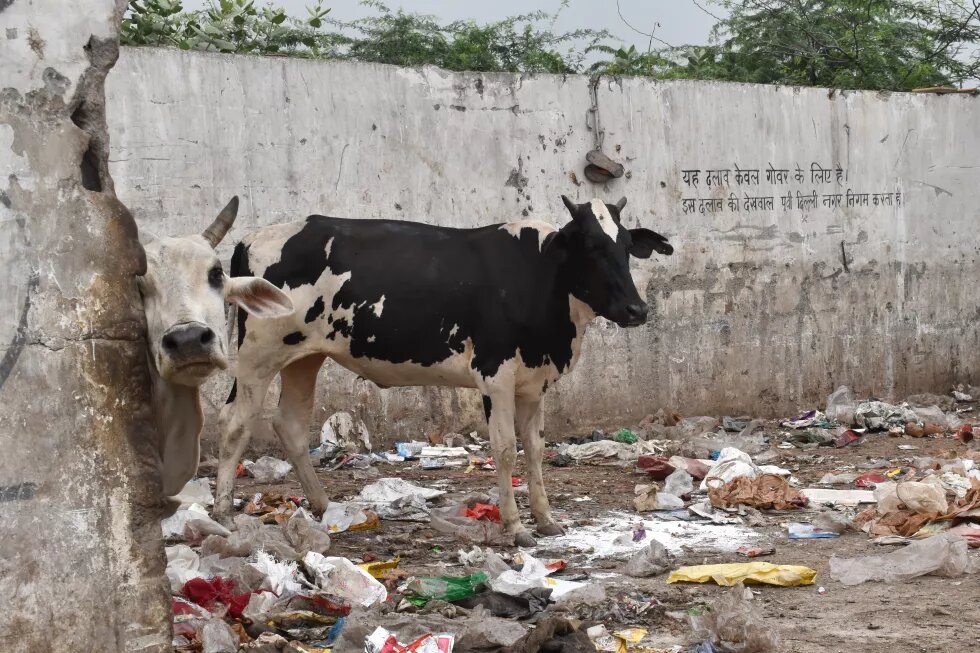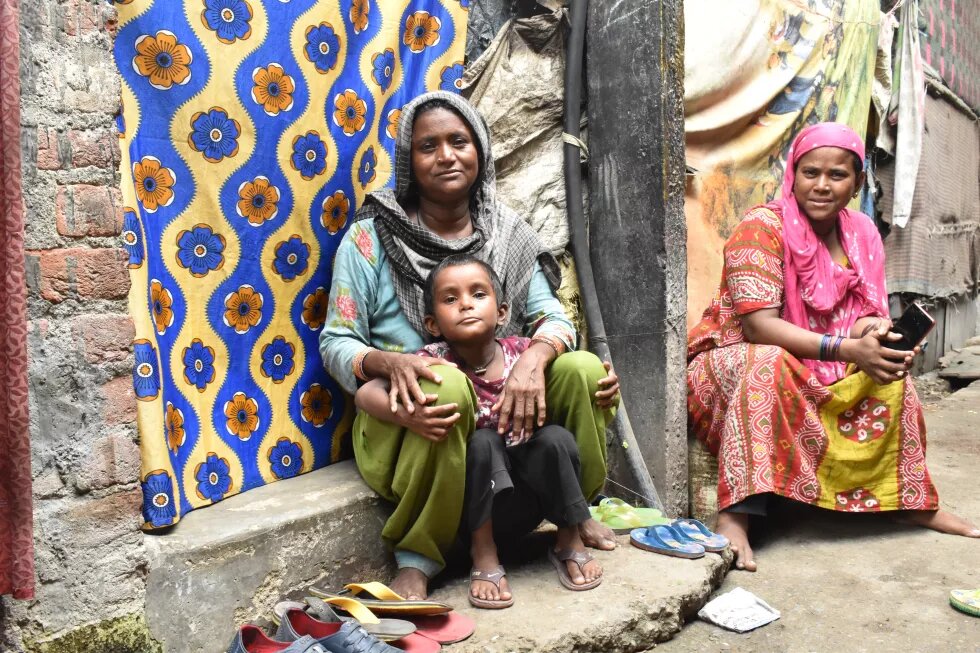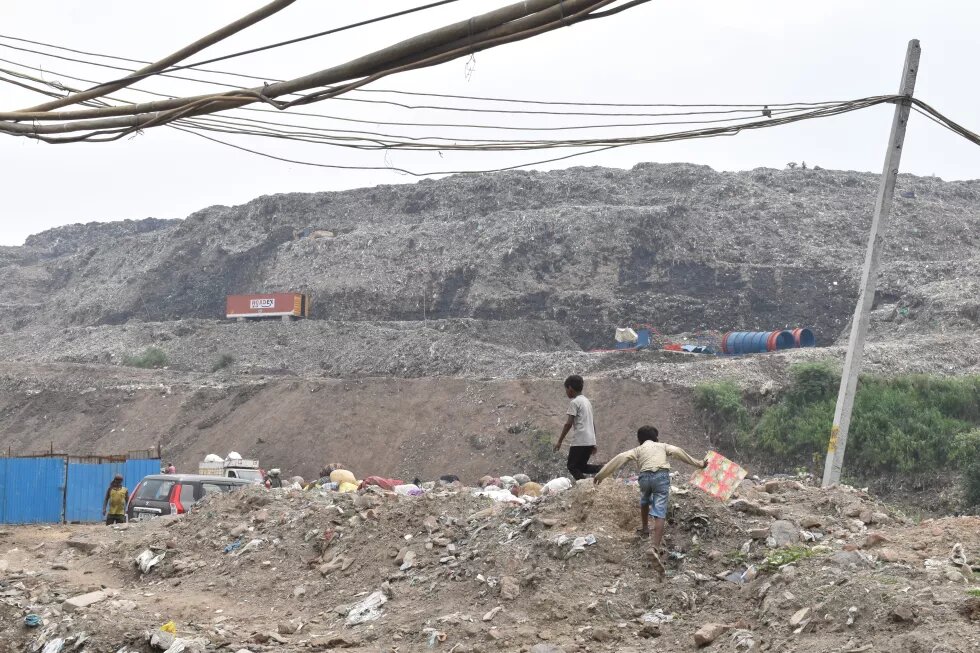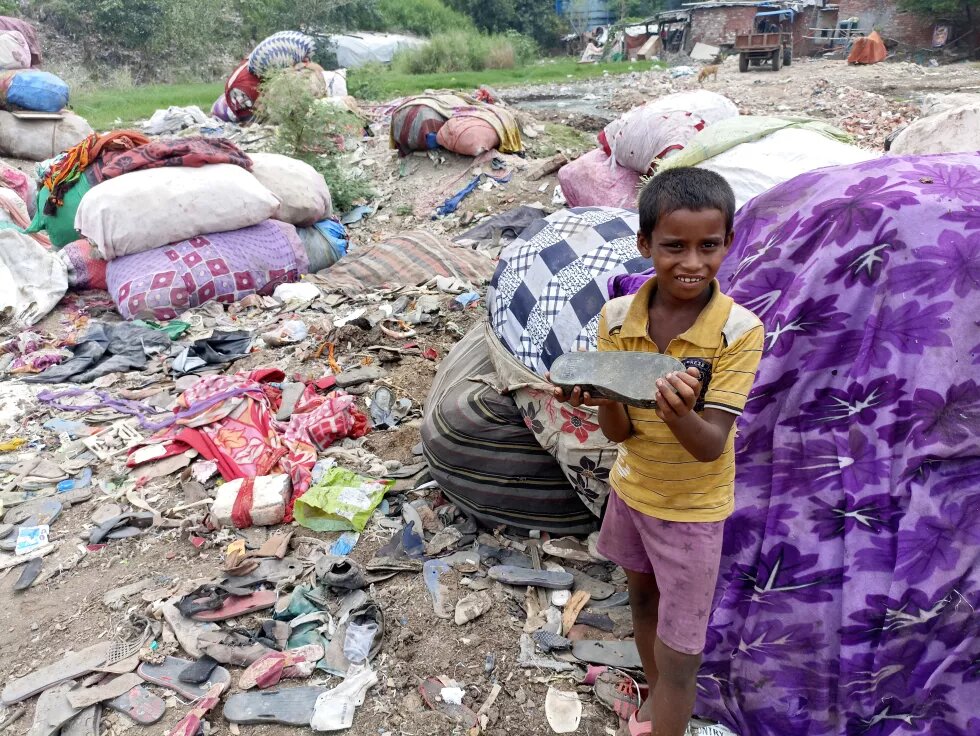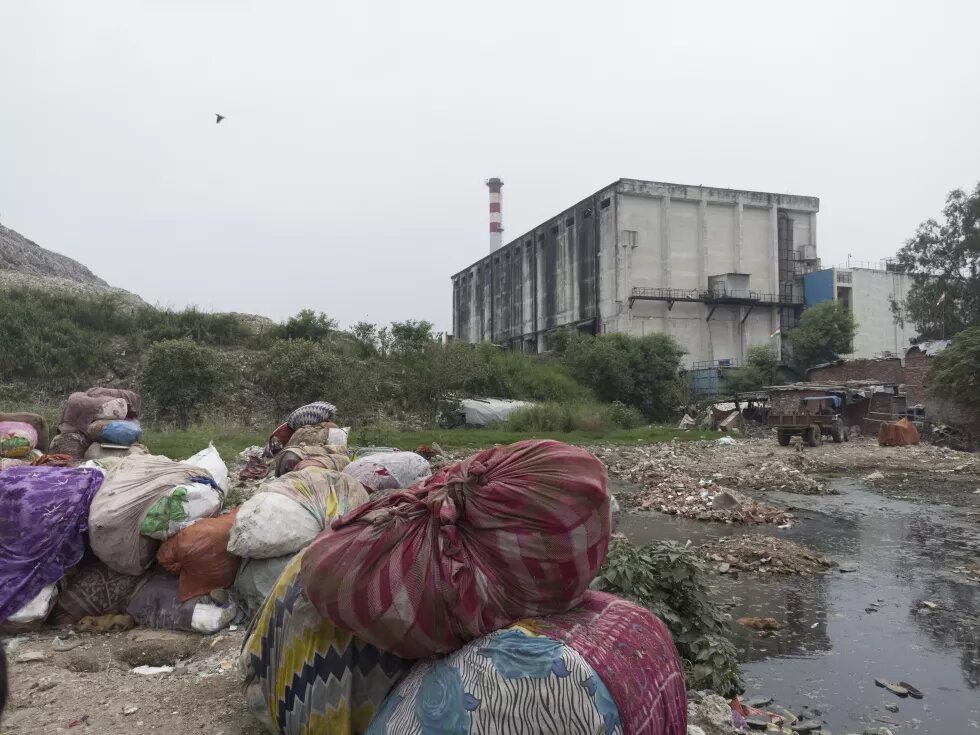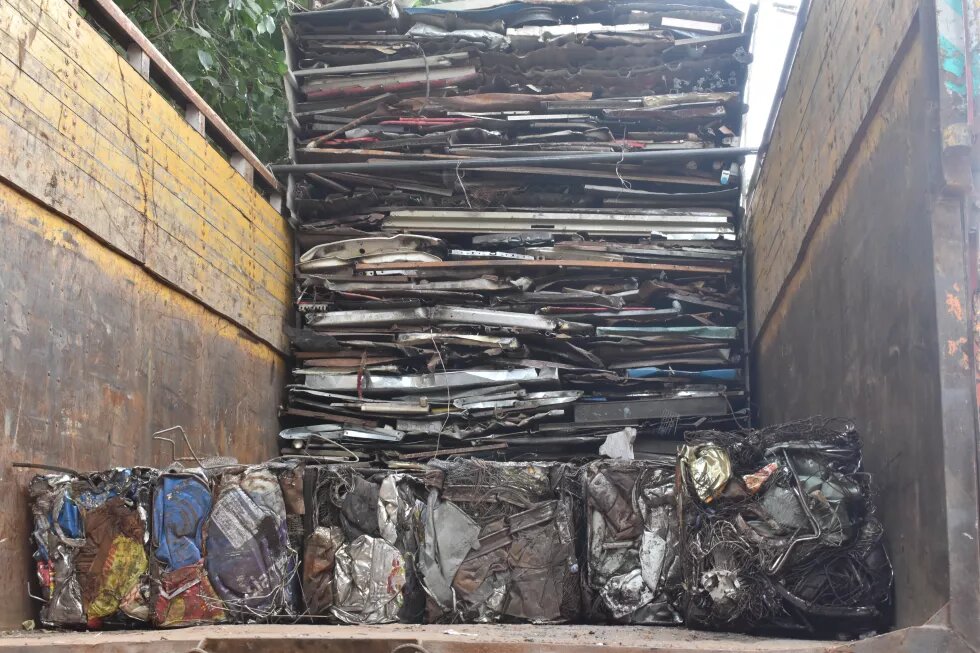
Lives and livelihoods of thousands of poor families are precariously connected to one of India’s biggest landfills.

As one walks past the Ghazipur dairy farm on one side and the humongous Ghazipur landfill on the other, you come across several lanes (galis) one after the other with brick buildings and families living inside them. Although there is a lot of construction dust and metal scraps lying around, and a constant fume coming from the Ghazipur landfill, one can tell that these houses belong to the area’s well off families with their own two wheelers or cars and children in clean clothes, wearing slippers or shoes (a sharp contrast to the waste pickers’ children I met later).
I am Srijani, a Sociology student in my final year of undergraduation. I have always been keen on understanding the waste value chain, which exists in a city like Delhi, where on one hand almost all materials have a resale value, while on the other, we have a burgeoning problem of waste as evident by the ever increasing height of our landfills. What takes me to Ghazipur is the curiosity to know more about women who work as waste pickers near this landfill. The adverse impacts of living near a landfill, and working with waste on the health of waste workers has been highlighted time and again. Mostly, I am looking to understand what are the perceptions, work conditions and aspirations of women waste workers.
I am really looking forward to meeting these women, and learning from them. However, on the roads, or on the front side of the landfill, I can't see a single woman around. Even people nearby tell me that they don't know any women who work with waste. However, I am not convinced, and I keep walking along the main road, in hopes of coming across a group of women workers or their dwellings.
Towards the end of the road and just before the flyover begins, I peep inside the last gali on that road. To my delight, I find a lively series of small houses filled with women peeling vegetables, scolding their children, and chatting with each other. As I keep walking through the narrow gali, flanked by houses on both sides I see several women sitting outside on the steps of their homes. From the outside, one would never be able to even see this road that leads up the homes of waste pickers, remaining tucked away in a corner from the city’s sight.
I strike up a conversation with a group of women sitting nearby, asking them whether they know any waste pickers in that area. Very proudly they tell me that they are the workers I am looking for, they pick waste and sell whatever materials they find to make an honest living. They pick out plastics and metals from the garbage dump situated about 1-2 km from their house and sell it to scrap dealers and earn money from it. Mahiya, 55, the oldest among them, tells me that the majority of the people there are waste pickers, mostly because they won’t get any other jobs. Their entire families are involved in this kind of work. Most of their children go to school. However, many of them still work with their parents on the garbage dump. Children as young as four or five learn how to segregate and pick waste from their parents by observing how they work.
Plastic types, value chain and workers’ rights
Mahiya migrated to Delhi from West Bengal 30 years ago and she has seen the Ghazipur landfill grow into a mountain from the very beginning. Out of all items made out of plastic, plastic bottles are the most common items found in the garbage. Mahiya and her friend, Aamaya, 50, tell me that now fewer bottles have started coming to the landfill as bigger housing societies segregate their waste at source. Plastic boxes, utensils, and buckets are still found in large numbers. Most of these plastic items, which they get a hold of, are soiled or broken already. The waste objects in relatively good conditions are either sold directly to kabadiwalas (scrap dealers) or are picked up by workers of the formal recycling sector. A good deal of polythene bags are also still found, which was also evident from the surrounding areas where plastic bags were strewn everywhere. The waste pickers pick and sell about 12-13 kg of plastic waste in a day, at the rate of Rs.10 to Rs.12 per kg.
Even during the COVID-19 pandemic, they continued to go out and do this work since they rely on a daily income generated from selling the waste they pick. Sadhna, 22, the youngest among them, says that they were not afraid of the coronavirus simply because they were more concerned about not dying of hunger. There are many studies, which show that waste pickers and workers in India face adverse health complications due to the unsanitary nature of their work conditions. These women tell me that even if they fall sick due to working with waste and living near a landfill, they don’t realise it, mainly because they have grown up here and are accustomed to these conditions. Sometimes they feel like vomiting, feel dizzy and even their blood pressure falls. They just pop some pills or take rest to feel good enough to go to work.
“Yeah hum logo ka jo kaam hai, kar rahe hai toh kha rahe hai warna bhuke rahenge
(In our job, we get food as long as we work; we will starve if we stop working)”A woman waste picker in her 50s
Sadhna tells me that there are several NGOs and people who come to their slums, and promise them formal employment, but these women have realised that these are false promises and these people are never to return again. They want formal employment because it would not only guarantee them a fixed income per month, but also give them respect in society. Often, waste workers are perceived as people who are ‘unclean’ and ‘polluted’, which does not just relate to their occupation, but also the caste they belong to. Traditionally lower castes in India were relegated to all waste related work, often in very humiliating and unhygienic conditions. Even today, a majority of the people in various sectors of the waste industry such as garbage collectors, kabadiwalas, waste pickers, and sweepers, belong to Scheduled Castes. This is also why many of them want to be employed elsewhere, in different kinds of industries.
Children of Ghazipur
They ask me to walk further along to find the place where all the garbage is dumped, their place of work. A young boy of 12 years, Amir, guides me through the galis towards the dumping ground. On the way we find more of his friends flying kites amongst the garbage. They are flying a kite made out of plastic, an item traditionally made out of colourful paper in India. I ask them who all pick waste with their parents. Most of them point at each other saying, “I don’t pick waste, but he does”. It takes the young boys some time to open up, but they eventually tell me the tales of all the things they find in the garbage dump.
Mohan, 9, tells me that he once found silver in the waste and handed it over to his older sister. Amir and his friends lead me towards the landfill where their parents go to work. On the way they tell me that they often go to the landfill to give water to their parents, as there is no water supply up there. Sometimes there are fires in the landfill and since they live so close by, the smoke reaches their homes and makes it very hard for them to breathe. They also tell me that there have been deaths at the landfill as waste pickers have gotten buried under heaps of garbage, or even due to heat and thirst. Most of these deaths, caused due to the waste generated by us, are not even reported in the news.
On the way, I see choked gutters, waste strewn along the path, huge trucks going in and coming out with segregated items such as metals, plastics and glass. The kids are picking up and playing with random objects they find lying on the street. They are very excited to take me to this landfill where they work and play, as that is their own backyard.
As I keep following the boy with the kite, we come up to the backside of the Ghazipur landfill where the waste pickers are working. Its size, the stinking smell and smoke are an alarming reminder of what we have done to our own city. More than anything, seeing children live, play and grow up here is a stark reminder of the disproportionate impact of the waste generated by the wealthiest in the city on the marginalised. What we discard becomes a part of the immediate environment of these children. They grow up living around or playing with toxic plastic items, which are soiled, broken or burnt.
View from the top: Private versus informal
These boys run towards the heaps of garbage lying around, and show me all the things they find interesting. A few of them pick up the plastic slippers lying around, and exclaim that Bata slippers have the best resale value. Plastic slippers, items we often forget about, dominate the landfill landscape. For the children, however, they are a replacement for balls; they play with the slippers by throwing them at each other. Amir also points towards a waste-to-energy plant operating there and shows me a crane type machine picking up heaps of garbage and putting it inside the plant. The waste then burns inside the plant and produces black smoke, according to the kids. This side of the landfill has several waste pickers from the nearby slums working on it, picking waste in a large sack.
The passersby see just the front side of the Ghazipur landfill; usually, they can only see large trommel machines and trucks working on the mountain of garbage. However, the waste pickers, who, historically and at present, form a vital part of the waste management system, remain hidden in plain sight to the average urban middle or upper class dweller. Formalising waste pickers would help to protect them from exploitation by recyclers or kabadiwalas who give these workers lower prices for their material, especially giving the lowest price to women and children. Formalising this sector would also help provide these workers safer conditions of work, where they would have a ventilated workplace, with gloves and masks being given to them.
While leaving the site around 4 pm or 5 pm, I see 35-year-old Sunita going to the landfill again with her bag to pick up more waste. As my day draws towards a close, the second leg of her work begins. I ask her a few questions about what all she finds on the heap of garbage and how many hours she works. Sunita tells me that the longer she works the more waste she is able to find in order to sell and earn money. She admits, though, that working here does have an adverse impact on women, especially the heat and the unhygienic conditions of work. Meanwhile, another woman returns after collecting all her precious finds at the garbage dump. She sweats profusely and excuses herself from having a conversation with me saying that she is too tired, feels dirty and has to go clean herself. As I head back home, I can feel the throbbing in my head as the smoke, heat and smell finally catch up to me and make me realise, yet again, the privilege of not living amongst the garbage that I produce.
